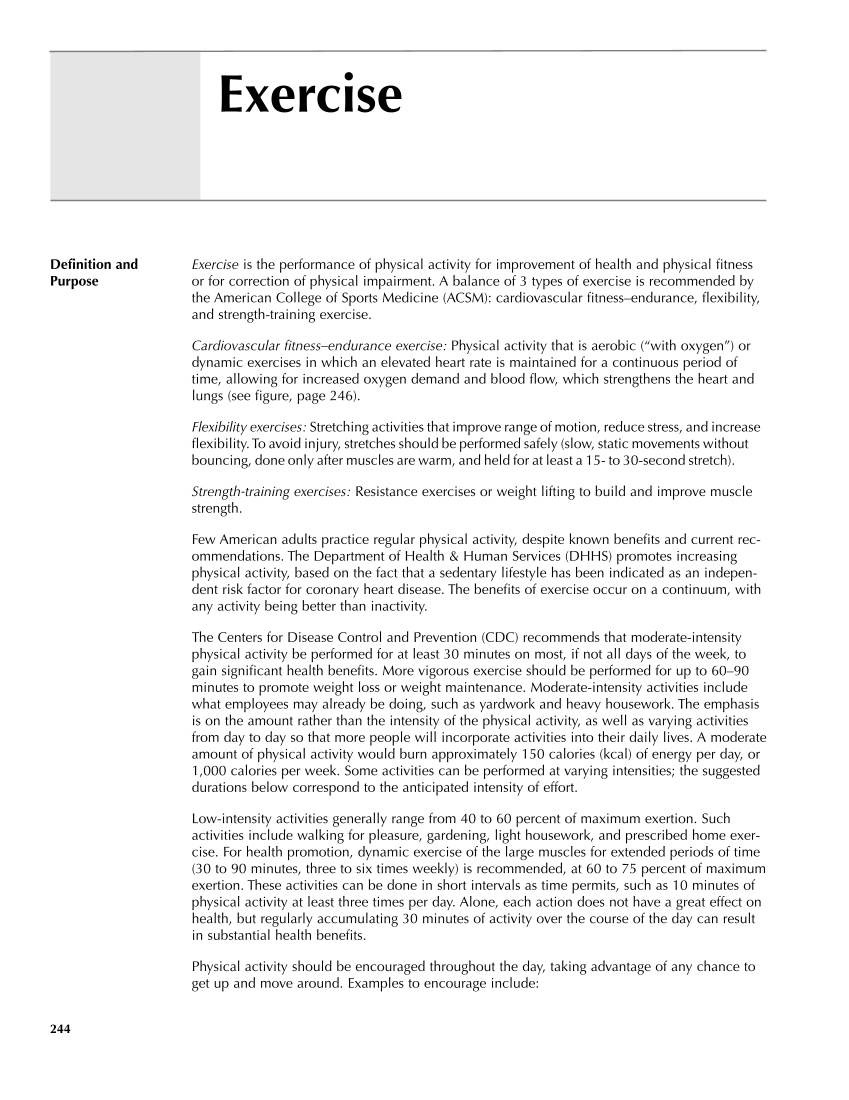Exercise is the performance of physical activity for improvement of health and physical fitness or for correction of physical impairment. A balance of 3 types of exercise is recommended by the American College of Sports Medicine (ACSM): cardiovascular fitness–endurance, flexibility, and strength-training exercise. Cardiovascular fitness–endurance exercise: Physical activity that is aerobic (“with oxygen”) or dynamic exercises in which an elevated heart rate is maintained for a continuous period of time, allowing for increased oxygen demand and blood flow, which strengthens the heart and lungs (see figure, page 246). Flexibility exercises: Stretching activities that improve range of motion, reduce stress, and increase flexibility. To avoid injury, stretches should be performed safely (slow, static movements without bouncing, done only after muscles are warm, and held for at least a 15- to 30-second stretch). Strength-training exercises: Resistance exercises or weight lifting to build and improve muscle strength. Few American adults practice regular physical activity, despite known benefits and current rec- ommendations. The Department of Health & Human Services (DHHS) promotes increasing physical activity, based on the fact that a sedentary lifestyle has been indicated as an indepen- dent risk factor for coronary heart disease. The benefits of exercise occur on a continuum, with any activity being better than inactivity. The Centers for Disease Control and Prevention (CDC) recommends that moderate-intensity physical activity be performed for at least 30 minutes on most, if not all days of the week, to gain significant health benefits. More vigorous exercise should be performed for up to 60–90 minutes to promote weight loss or weight maintenance. Moderate-intensity activities include what employees may already be doing, such as yardwork and heavy housework. The emphasis is on the amount rather than the intensity of the physical activity, as well as varying activities from day to day so that more people will incorporate activities into their daily lives. A moderate amount of physical activity would burn approximately 150 calories (kcal) of energy per day, or 1,000 calories per week. Some activities can be performed at varying intensities the suggested durations below correspond to the anticipated intensity of effort. Low-intensity activities generally range from 40 to 60 percent of maximum exertion. Such activities include walking for pleasure, gardening, light housework, and prescribed home exer- cise. For health promotion, dynamic exercise of the large muscles for extended periods of time (30 to 90 minutes, three to six times weekly) is recommended, at 60 to 75 percent of maximum exertion. These activities can be done in short intervals as time permits, such as 10 minutes of physical activity at least three times per day. Alone, each action does not have a great effect on health, but regularly accumulating 30 minutes of activity over the course of the day can result in substantial health benefits. Physical activity should be encouraged throughout the day, taking advantage of any chance to get up and move around. Examples to encourage include: 244 Definition and Purpose Exercise
Purchased from OEM Press by (ge corporate access). (C) 2013 OEM Health Information, Inc. All rights reserved.












































































































































































































































































































































































































































